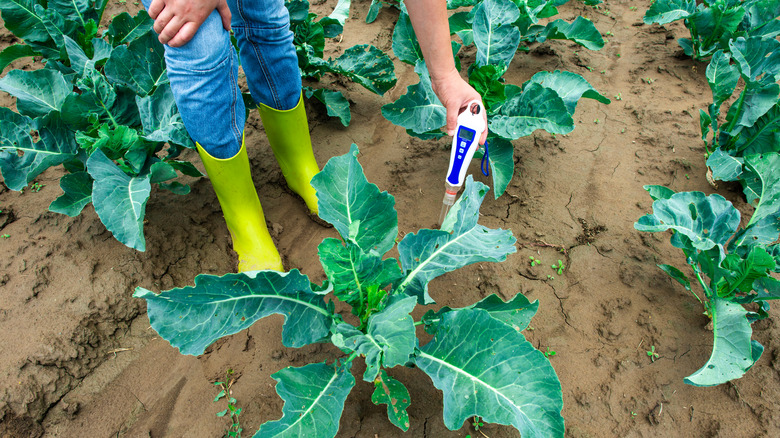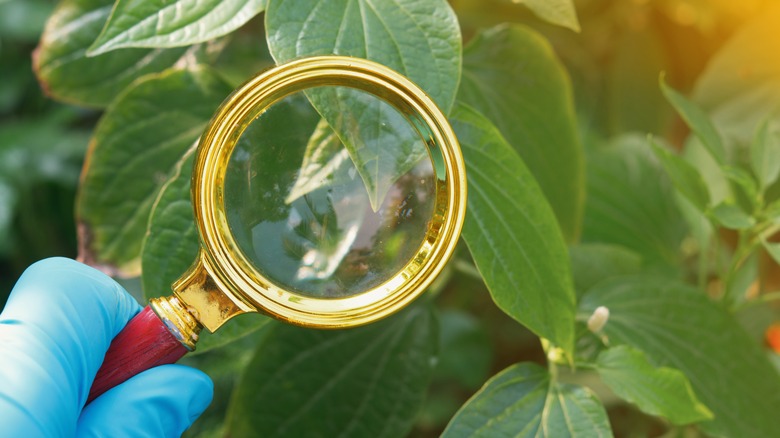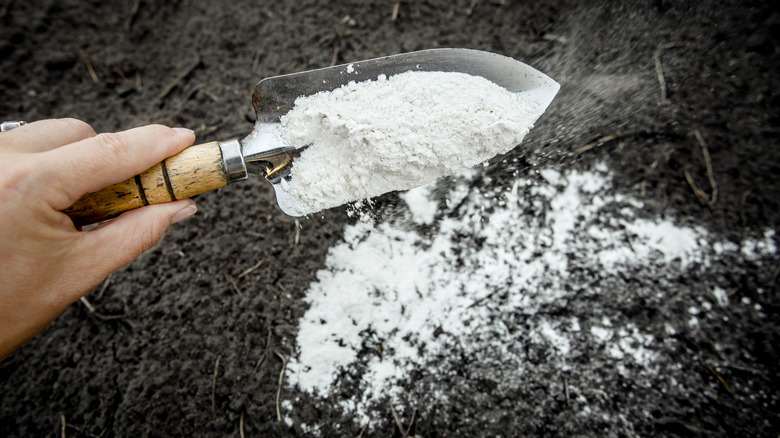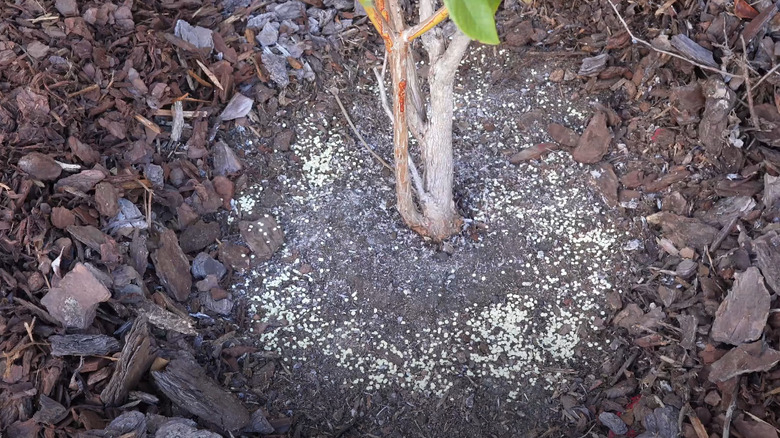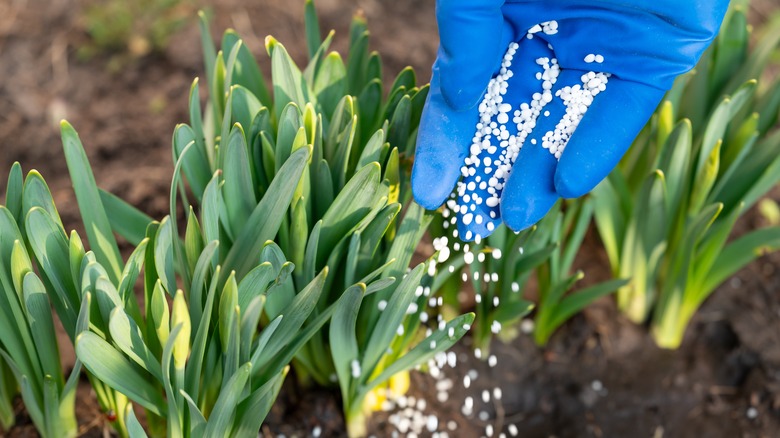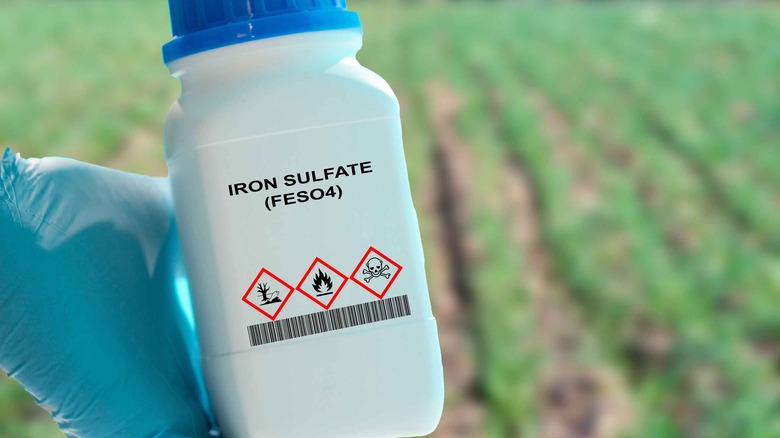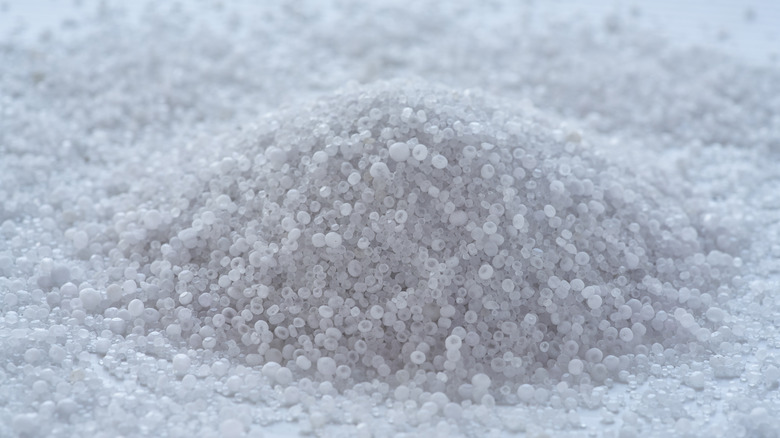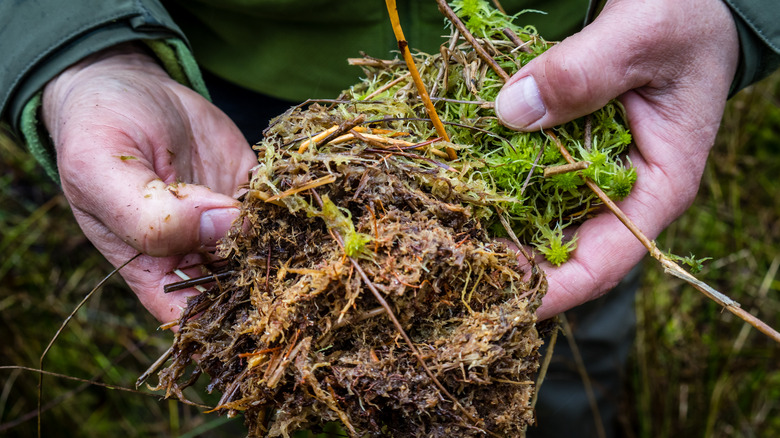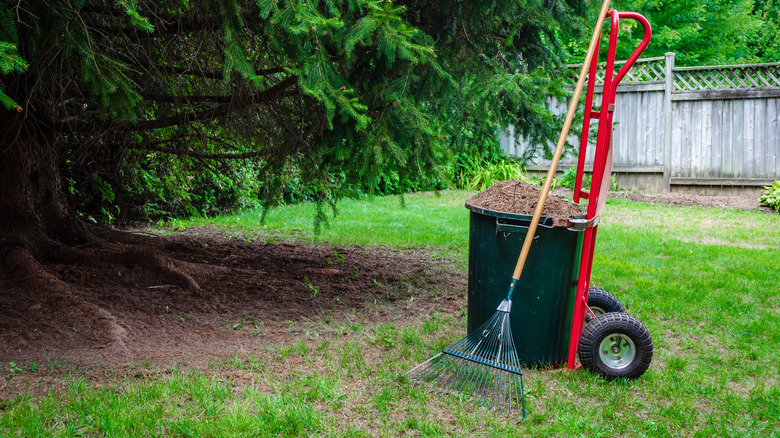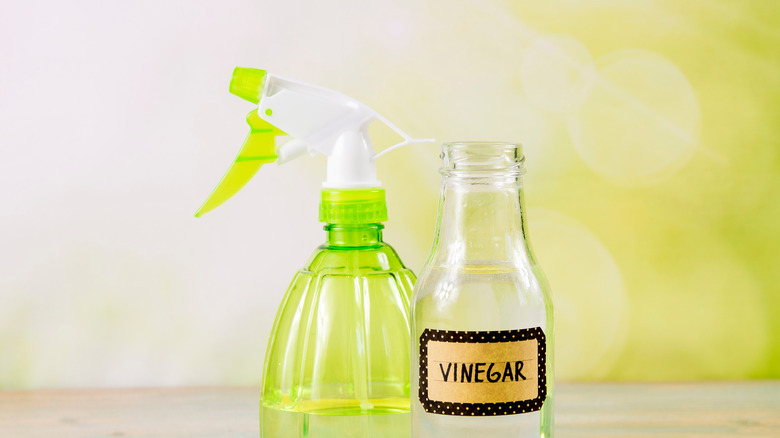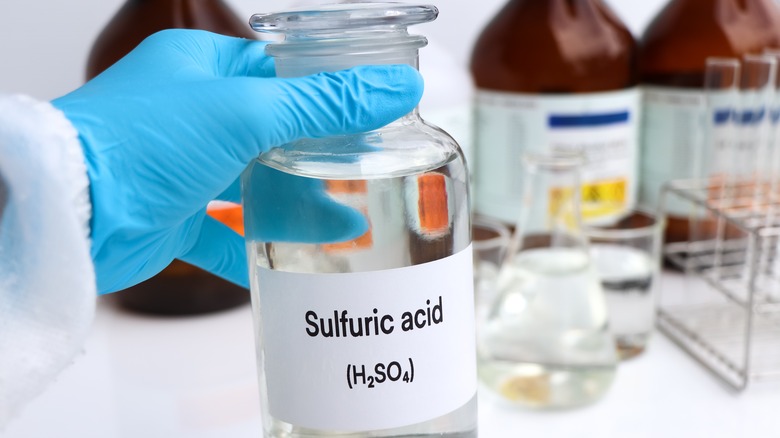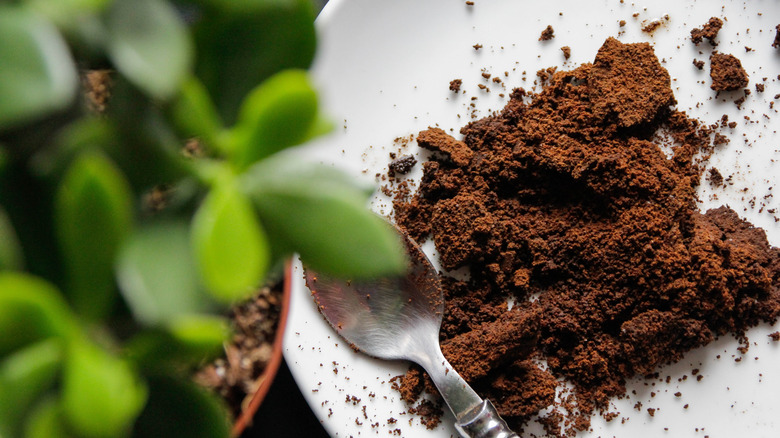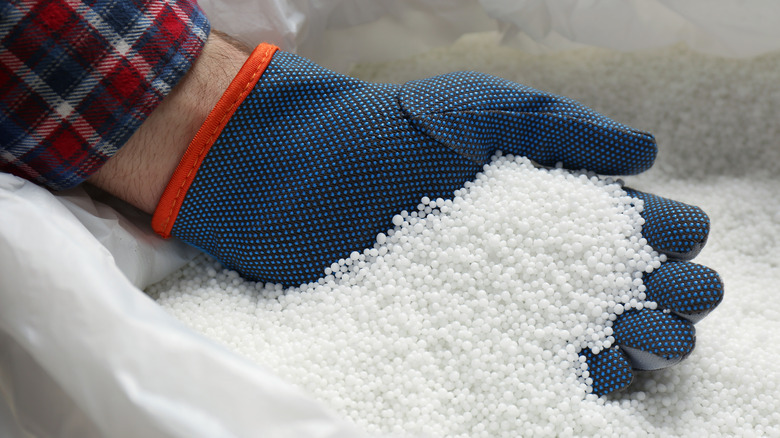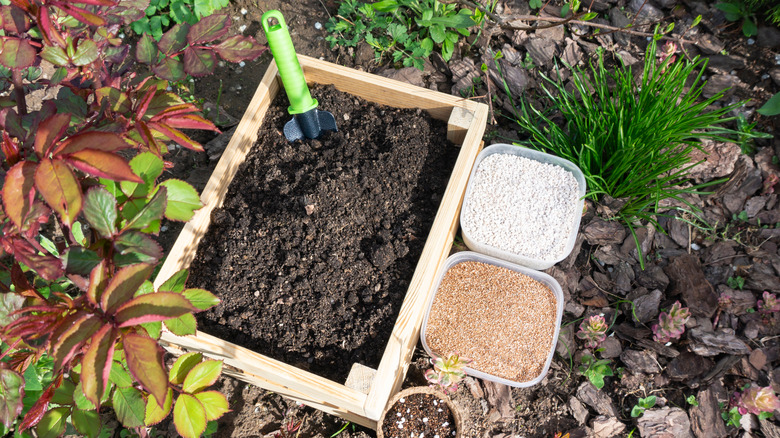6 Ways To Make Your Soil More Acidic For A Healthy Garden (And 5 To Avoid)
We may receive a commission on purchases made from links.
Soil pH is a critical factor for lawn and garden success. Very high (alkaline) or very low (acidic) pH levels decrease the availability of nutrients to plants, stunting their growth, so it's crucial for gardeners to get this number just right. If you're not sure what your garden soil's pH is, it's definitely wise to get it tested, especially if various species mysteriously struggle in your ground. Typically, there are three ways to measure a soil's pH: use a pH meter, employ vinegar, or send a soil sample out to your local university's agricultural department. Most pH meters you can get at places like The Home Depot (such as this meter for $41.51) are accurate enough for home garden use but need to be calibrated to ensure precise results. As for the vinegar hack, adding a drop of household vinegar to the soil will cause calcareous soils (soils with calcium carbonate) to fizz, which is a sign its pH should be over 7.5. However, just because a soil's pH is over 7.5, does not automatically mean it is calcareous, which can lead to user error during the test.
The most accurate method is getting a testing kit from a local university and sending your soil sample back for evaluation. A lot of agricultural departments will test your soil for a small fee or even free. Whatever method you choose, it's what comes next that matters. If you find your soil is a little too basic (sorry, but we just love a pun), don't worry; you're about to get the full low down on dropping pH. Here are ways you can increase your soil's acidity level on your own without hiring professionals, and a few you should avoid at all costs.
Signs your soil's acidity is too low
First, let's do a quick runover of how this all works and what you're looking for. For a brief science lesson, soil acidity is determined by a chemical reaction caused by the hydrogen and aluminum ions it contains. If a soil has an abundance of aluminum (AI3+) ions, they get converted into hydrogen ions (H+) via hydrolysis, increasing the acidity. To measure this acidity, we use pH. pH levels determine how acidic or alkaline something is and are measured on a scale from 0 to 14, with 7.0 being considered "neutral." The lower the pH level, the more acidic the soil. It might feel counterintuitive, but to increase acidity, you need to lower pH, ideally to between 6.0 and 7.0, for your garden's best access to the nutrients it needs.
But how do you know if you need to test your soil or start messing with its pH levels? Simply check out your garden. Plants are excellent at showing when it's time to intervene and they may give you a noticeable heads-up. Always check the new leaves since plants living in more alkaline soil will have their new growth affected first. Look for smaller-than-normal leaf development, pale green or yellow leaves that have bright, green veins, or brown, crispy edges. Keep in mind that each of these signs can indicate more than high pH levels, but seeing a consistent pattern across your plants could be a sign you need to get your soil tested.
Lower your soil's pH with aluminum sulfate
Aluminum sulfate is a popular option for increasing soil acidity because it mimics natural acid production. As aluminum sulfate dissolves, it releases aluminum (AI3+) ions. When the aluminum ions come into contact with water (H2O), they interact to create aluminum hydroxide complexes and release the leftover hydrogen ions (H+). The more hydrogen ions, the more acidic the soil.
If you need to up your acidity in a hurry, aluminum sulfate is great because it works fast thanks to its water solubility. However, you need to be careful with your measurements. Adding too much aluminum sulfate too fast can be harsh on plants, causing aluminum toxicity to their roots, especially if they're already nutrient-deficient. Also, it can get expensive if you're planning to treat a large area. To use aluminum sulfate, add it to soil before planting. Around 4 to 6 pounds per plant should drop your ground's pH by roughly a unit. If you're dealing with super alkaline soil, and want to plant acid-loving species, then you'll need to increase the quantity of aluminum sulfate accordingly.
Elemental sulfur is a cheap and effective way to increase soil acidity
Let's face it: The science stuff is kinda fun to learn about, but you're here for results, and your plants need those results sooner rather than later. If that's the case, look no further than elemental sulfur. Not only is it cheaper than most other additives, but it's quick. Elemental sulfur (S) is a tasty treat for bacteria, like Thiobacillus, which naturally occur in soil. Thiobacillus munches on the sulfur, converting it into sulfuric acid via oxidation. Sulphuric acid can effectively decrease the pH level of soil.
Since elemental sulfur is not water-soluble like other options we've listed, you'll need to manually mix it with your garden soil. Start by digging deep, pulling out the first six to eight inches of soil. Add a few cups of sulfur per plant and mix into the soil, then put it back into your garden. The exact amount will depend on your soil conditions and the type of plant, as some love more acidic conditions than others. To give you an idea, you will need between 35-56 pounds per 1,000 square feet to lower the soil's pH by half a unit. However, this should not be applied all in one year. The maximum amount per 1,000 feet to apply in a year is 20 pounds. You should also wait one full month before planting to give the sulfur time to settle in and oxidize. Full sulfur oxidization can take up to a year, so you may need to plan accordingly. Adding plants too early could cause root burn.
Nitrogen-based fertilizers can give you a small boost in soil acidity
If your soil only needs a little oomph in acidity, give nitrogen-based fertilizers a shot. They'll decrease pH by less than half a unit and can help slowly increase acidity over time. Generally speaking, these fertilizers are rich in various types of ammonium nitrogen (NH4+), which soil bacteria convert to nitrates (NO3-), leaving extra hydrogen ions, which then acidify the soil. Also, they're one of the few options that are safe to use for plants that are already in the ground; most others are easiest to apply in the pre-planting stage.
To effectively leverage nitrogen-based fertilizers, you'll want to use them earlier in the year rather than later, as too much nitrogen can mess with a plant's ability to produce crops, adversely affect vegetable yields, and cause lush yet weak growth that attracts pests. Do not be heavy-handed when applying in an attempt to quickly drop soil pH, and stick to the recommended amounts on the product. Apply yearly to maintain acidity levels, as soil can revert to its original pH if you don't keep up with your acid-increasing chores.
Use iron sulfate to lower soil pH levels
Iron or ferrous sulfate (FeSO4) works similarly to aluminum sulfate, except it gives the soil a little iron, which is an essential plant nutrient. This may be especially handy since high pH levels in soil can lead to plants having an iron deficiency. Iron sulfate is a fast-acting, water-soluble soil additive that binds iron ions to clay particles, supplanting hydrogen ions that can then acidify the soil.
However, iron sulfate has a few downsides, too. First, you'll need a lot of it; the Royal Horticultural Society recommends using it at eight times the dosage level you'd use for elemental sulfur. Consequently, it can get expensive quickly, especially when compared to straight sulfur. So why would you go this route? It's best to use if you're in a hurry, since iron sulfate lowers pH faster than elemental sulfur. That's because it works through chemical reactions, not biological ones. (An example of a biological reaction is waiting for the bacteria to consume the sulfur, convert it into sulfuric acid via oxidation, and lower the pH of the soil.) Gardeners who decide to try iron sulfate also need to be careful since using too much can be a problem, as it can decrease phosphorus availability. If you decide to go with this method, you'll need to learn how to identify and treat nutrient deficiencies in plants to keep your garden healthy.
Ammonium sulfate raises acidity levels in soil better than other fertilizers
Ammonium sulfate, or (NH4)2SO4, is a common nitrogen-based-fertilizer. We've already discussed nitrogen-based fertilizers as a whole, but this particular type is a powerful ally to have on its own, supplying twice the acidity levels of other nitrogen-based fertilizers, which is why we want to discuss it specifically. Like other nitrogen-based fertilizers, it increases the acidity levels of soil through a process called nitrification, which converts ammonia into nitrite (NO2-) and then nitrate (NO3-), leaving leftover hydrogen ions that increase soil acidity.
Despite it sounding like a chemical you'd need some sort of licensing to get, ammonium sulfate is pretty easy to find and it's safe to sprinkle on top of your soil. However, you'll need a lot of it, about 2.8 times the level you'd need of elemental sulfur to do the same job. If you are looking to slowly drop pH while feeding your garden, some 10-10-10 NPK fertilizers also contain ammonium sulfate (such as this blueberry fertilizer from Old Cobbler's Farm on Amazon, which costs $21.99 for 5 pounds). Applying a balanced fertilizer can get you more bang for your buck, as you'll only have to purchase one product. However, if you're just looking for a source of nitrogen along with a drop in pH, then plain ammonium sulfate could be better.
Some sphagnum peat moss has soil-acidifying abilities
Let's say you'd prefer to skip the chemicals and opt for something a little more "au naturel." You're in luck, thanks to sphagnum peat moss. However, the details matter with this, as just any kind of sphagnum moss won't do; you need the Canadian kind. Canadian sphagnum moss has a pH of between 3.0-4.5, which can help reduce the pH level of the soil it's buried in. Also, Canadian sphagnum can be added directly into the hole your new plant is going, making it great for impatient gardeners.
For the best impact on your soil's acidity levels, don't use sphagnum moss alone but as an extra additive to other methods. A 2021 study in the scientific journal "Plants" found that adding a combination of sphagnum moss and elemental sulfur to soil rich in sulfur-oxidizing bacteria yielded noticeable declines in soil pH levels. That's the good news. The bad news is you'll need a lot of peat moss to yield results. The same study saw some pH shifts by using a soil mixture that was between 10-20% moss, but the most significant results happened when the blend contained 30-50% peat moss. Further, while peat moss is natural, it's typically not harvested in sustainable ways and can cause damage to the ecosystems where it was removed from.
It's a myth that pine needles help increase soil acidity
Pine needles are sometimes touted as helping increase soil acidity, but the evidence is anecdotal at best. Pine trees thrive in acidic, well-draining soil and rarely have plants growing under them. This may lead someone to assume the tree is causing the soil to be too acidic for any understory species to handle. Unfortunately, that's not the case; pine trees grow in soil that's already acidic, and their lack of understory companions is thought to likely be due to their root system pervading the shallow layers of soil and their branches blocking sunlight.
While it's true that pine needles do have a low pH (typically around 3.2-3.8), that's only when they're freshly fallen. As the needles begin to decompose, the microbes in the soil neutralize their acidity. Even if you shook an entire tree loose of its needles, it wouldn't help. But don't give up on pine needles for the garden just yet, as they make an excellent mulch that smells amazing and stays loose enough to let air and water in but compact enough to prevent weed growth and stay in place when lighter mulches like regular leaf litter could blow or wash away.
Vinegar is too harsh on plants to be used as a soil acidifier
Do you want an amazing, cheap, and powerful ally for your home? Look no further than vinegar. Vinegar is a versatile cleaning tool, knocking out scum like nobody's business. There are also various ways to use vinegar to get rid of pests. It's chock-full of acetic acid, which you might think would work as a soil acidifier. Unfortunately, it's just not the right kind of acid.
But let's say you pour an entire gallon of white vinegar straight into the soil, would that work? Not only might it fail spectacularly, but it may also cause way more damage than you'd think. Vinegar rapidly breaks down once it's introduced to soil, but its acidic nature can wreak havoc on certain species in the process, burning any plant tissue it accidentally splashes. This is one of the reasons why you can use vinegar-based weed killers as an alternative to Roundup. That said, while vinegar can harm plants, there is a method commercial farmers use called "acidified irrigation" that follows the same principle and helps already-acidic soil maintain its pH levels. But the precise measurements and irrigation process mean it's better suited for large-scale farms than our backyard gardens.
Sulfuric acid is effective but just too dangerous to deal with
Sulfuric acid (H2SO4) occurs as a natural result of bacteria that are already in the soil breaking down elemental sulfur. On its own, sulfuric acid is a fast-acting, powerful soil additive for lowering pH. Some professionals in the green industry even use it to reduce soil pH around large, well-established trees. So why are we saying it's an additive to avoid if it's so successful at its job? Unfortunately, because it's just too dangerous.
You might know sulfuric acid by a more common name: battery acid. If you accidentally get it on you, things can get bad quickly. Sulfuric acid is highly corrosive, causing tissue necrosis, eye damage, or even death in humans. Plus, it can be dangerous to the environment, contributing (on an industrial level) to the development of acid rain. There are so many safer alternatives out there that can do the same job that it's just not worth the risk to you or your loved ones' health and your yard's ecosystem.
Coffee grounds cannot lower the pH of soil
When added to soil, coffee grounds have some fantastic benefits. They provide small amounts of nutrients and improve soil structure and drainage. However, despite their soil-building benefits and the fact that some roasts are naturally acidic, they don't have the ability to lower pH. But don't toss them just yet because there are lots of other ways you can use coffee to improve your lawn and garden.
Once brewed, coffee grounds drop their acidic levels to between 6.5 and 6.8 pH, which is close to neutral. So while coffee grounds won't help you adjust soil pH, they also won't throw it off over time — which is good news if you want to start mulching with coffee grounds. Coffee grounds have been shown to substantially improve soil structure and be a good source of phosphorous, copper, potassium, and magnesium. However, some plants prefer to live a caffeine-free life and have shown slower growth when coffee grounds are added to their soil. If you're worried about coffee inhibiting growth in caffeine-sensitive species, simply add it to the compost pile rather than directly applying the spent grounds to your garden.
Ammonium nitrate is an effective soil acidifier but it's just too hard to get
Ammonium nitrate (NH4NO3) is sometimes confused with ammonium calcium nitrate [Ca(NO3)2 NH4NO3] and it's easy to understand why. They both have similar names and are high in nitrogen. However, they differ in several ways. Ammonium calcium nitrate, which you can usually find at hardware or farm supply stores, contains 15% nitrogen. On the other hand, ammonium nitrate has 34% nitrogen and can be harder to find, often being used more by professionals. If you need a quick way to acidify your soil, you might think that the latter option is a better choice for your garden.
However, this powerful soil additive is pretty hard to get. Why? Well, to make a long story short, it's sometimes used as an accelerant in explosives. Consequently, there are stringent government regulations for who can buy ammonium nitrate, which makes it a hassle for retail stores to keep in stock. There are more readily available options on this list that are just as effective, which is why we think you should skip it and go for something else.
Things to keep in mind when trying to make soil more acidic
Let's talk about what to do once you get your results from the soil test back. First, you'll need to pick your plants based on their pH preferences. Most plants will grow in neutral pH, but there are acid-loving plants that require more care like azaleas, rhododendrons, and blueberries. Understand what your test results tell you and judge which plants to add based on that data and how much effort you want to put into amending your soil.
Next, pick your additive and calculate how much you'll need. Clemson University has a helpful set of tables for calculating the amount of aluminum sulfate or sulfur required based on the pH level change you want to make. Alternatively, your local horticultural society may be helpful. Once you've decided on the amendment and amount, it's time to prep your soil for successful planting. It's best to incorporate your additive before planting so that the soil's pH has time to adjust, which usually takes at least six months. However, if you're trying to correct pH levels around pre-existing plants, try carefully acidifying a small area around the root ball in the fall months — unless you're using fertilizer to help drop pH. In this case fertilize at the correct time of year, usually at the start of or during the growing season.
